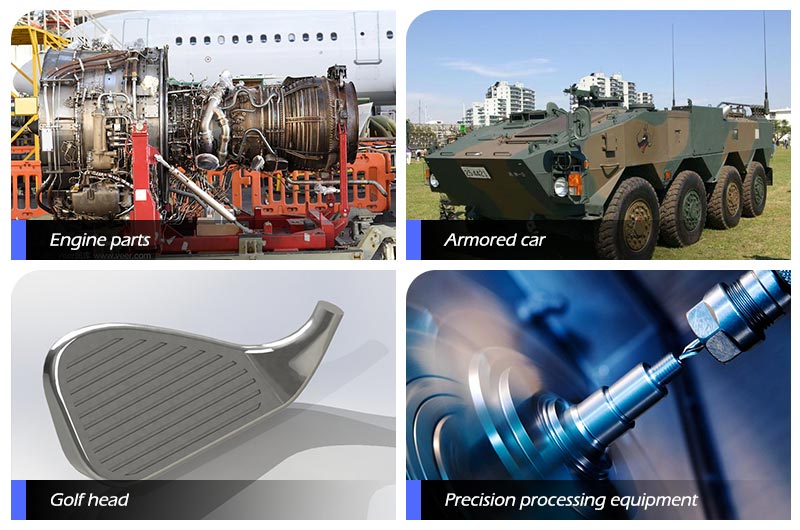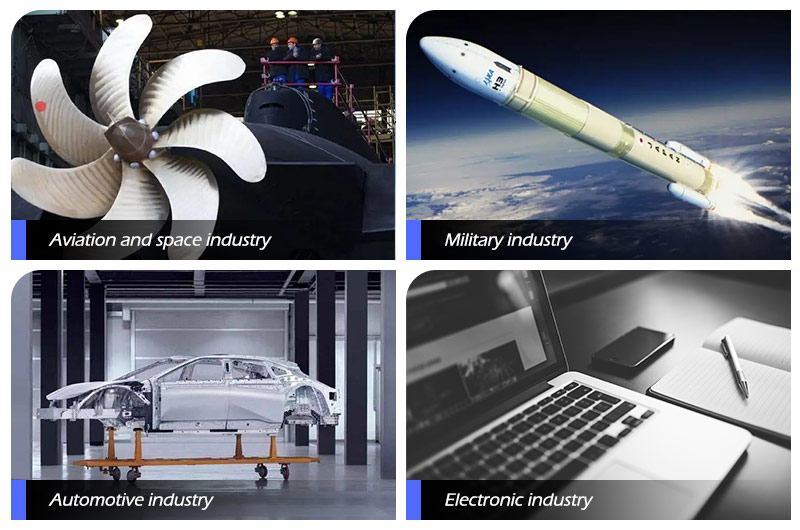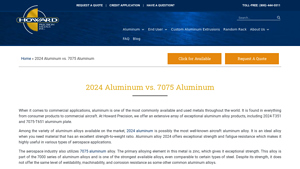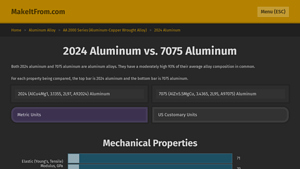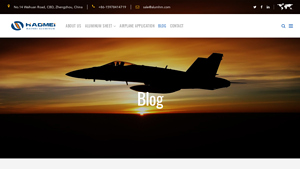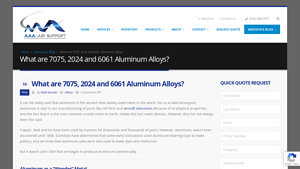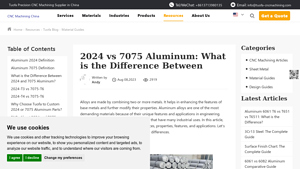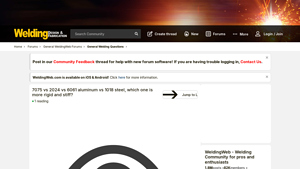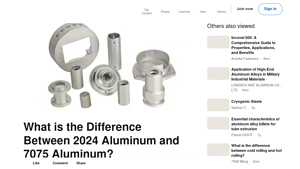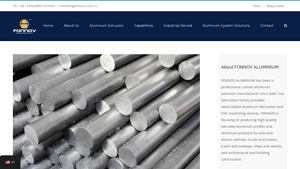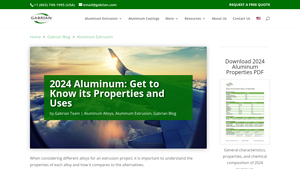2024 Vs 7075 Guide: Type, Cost, Top List…
Introduction: Navigating the Global Market for 2024 vs 7075
In the competitive landscape of international manufacturing, choosing the right aluminum alloy can be a pivotal challenge for B2B buyers. The decision between 2024 and 7075 aluminum alloys is not merely a technical specification; it encompasses critical factors such as mechanical performance, industry applications, and cost-effectiveness. This guide provides a comprehensive analysis of these two prominent aluminum alloys, enabling buyers to navigate their differences effectively.
We delve into the chemical compositions, mechanical properties, and applications of both alloys, highlighting their strengths and weaknesses in various industries, particularly aerospace, automotive, and construction. Additionally, we offer insights on supplier vetting, ensuring that international buyers—especially from regions like Africa, South America, the Middle East, and Europe (including Germany and Brazil)—can make informed sourcing decisions.
By understanding the unique characteristics and applications of 2024 and 7075 aluminum alloys, B2B buyers will be better equipped to select materials that meet their specific project requirements while optimizing performance and cost. This guide is designed to empower you with actionable insights, ensuring your purchasing decisions are grounded in comprehensive knowledge of the global aluminum market.
Understanding 2024 vs 7075 Types and Variations
| Type Name | Key Distinguishing Features | Primary B2B Applications | Brief Pros & Cons for Buyers |
|---|---|---|---|
| 2024 T3 Aluminum | High strength, excellent fatigue resistance, lower corrosion resistance | Aerospace structures, military applications | Pros: Lightweight, good machinability. Cons: Poor corrosion resistance, difficult welding. |
| 2024 T6 Aluminum | Enhanced strength, good thermal properties | Aircraft components, automotive parts | Pros: High yield strength, suitable for high-stress applications. Cons: Limited weldability, lower corrosion resistance. |
| 7075 T6 Aluminum | Exceptional strength, similar to steel, average machinability | Aerospace, military, sporting goods | Pros: Very high strength-to-weight ratio. Cons: Difficult to weld, higher cost. |
| 7075 T651 Aluminum | Improved toughness, good fatigue strength | Structural components, tooling | Pros: Good machinability, high strength. Cons: More expensive, limited corrosion resistance. |
| 7075 T7351 Aluminum | Excellent strength and stability under stress | Aerospace, defense, heavy machinery | Pros: Strongest aluminum alloy, good thermal properties. Cons: Challenging to process, high cost. |
What Are the Characteristics of 2024 T3 Aluminum?
2024 T3 aluminum is renowned for its high strength and excellent fatigue resistance, making it a preferred choice in aerospace and military applications. This alloy contains a higher copper content, which enhances its strength but slightly compromises its corrosion resistance. B2B buyers should consider its suitability for applications requiring lightweight materials that can endure significant stress. However, its poor weldability and susceptibility to stress corrosion cracking necessitate careful handling and processing.
Why Choose 2024 T6 Aluminum for Aerospace Applications?
2024 T6 aluminum offers enhanced strength and thermal properties compared to its T3 counterpart. This variant is particularly suited for aircraft components and automotive parts where high yield strength is crucial. B2B buyers should weigh its advantages in high-stress environments against its limited weldability and corrosion resistance. This makes it ideal for applications where structural integrity is paramount, but additional protective measures may be required to mitigate corrosion risks.
How Does 7075 T6 Aluminum Stand Out in the Market?
7075 T6 aluminum is celebrated for its exceptional strength, often compared to that of steel, making it a top choice for aerospace and military applications. Its average machinability allows for versatile manufacturing processes, although its high strength can pose challenges during welding. For B2B buyers, the strength-to-weight ratio is a significant advantage, especially in industries where performance is critical. However, the higher cost and processing difficulties should be factored into purchasing decisions.
What Are the Benefits of 7075 T651 Aluminum in Structural Applications?
7075 T651 aluminum is recognized for its improved toughness and good fatigue strength, making it suitable for structural components and tooling. Its good machinability allows for efficient manufacturing, which is a key consideration for B2B buyers looking to optimize production costs. While it offers high strength, its limited corrosion resistance and higher price point compared to other alloys may influence procurement strategies, especially in environments with high exposure to corrosive elements.
Why Is 7075 T7351 Aluminum Ideal for Heavy Machinery?
7075 T7351 aluminum is one of the strongest aluminum alloys available, providing excellent strength and stability under stress, making it ideal for aerospace, defense, and heavy machinery applications. B2B buyers should consider its superior thermal properties and fatigue resistance, which enhance performance in demanding environments. However, the challenges associated with processing this alloy, coupled with its higher cost, necessitate a careful evaluation of its long-term benefits versus initial investment.
Key Industrial Applications of 2024 vs 7075
| Industry/Sector | Specific Application of 2024 vs 7075 | Value/Benefit for the Business | Key Sourcing Considerations for this Application |
|---|---|---|---|
| Aerospace | Aircraft structures and components | High strength-to-weight ratio enhances fuel efficiency and performance | Compliance with aerospace standards (AMS, ASTM) and certification requirements |
| Defense and Military | Armored vehicles and weaponry | Exceptional strength and durability under extreme conditions | Need for custom specifications and rigorous testing protocols |
| Automotive | High-performance vehicle parts | Lightweight materials improve fuel economy and handling | Consideration of corrosion resistance and manufacturing capabilities |
| Construction | Structural components for bridges and buildings | Strong, lightweight materials reduce overall construction costs | Availability of large-format sheets and specialized fabrication services |
| Sports Equipment | High-stress components in bicycles and sporting goods | Enhanced performance and durability for competitive advantage | Demand for precise tolerances and aesthetic finishes |
How is 2024 Aluminum Alloy Applied in Aerospace and What Are Its Benefits?
2024 aluminum alloy is predominantly used in the aerospace industry for aircraft structures and components. Its high strength-to-weight ratio significantly contributes to fuel efficiency and overall aircraft performance. Buyers in this sector must ensure that their sourcing meets strict aerospace standards, such as AMS and ASTM certifications, to guarantee safety and reliability. Additionally, the alloy’s susceptibility to corrosion necessitates protective coatings or treatments, which should be factored into procurement strategies.
What Role Does 7075 Aluminum Play in Defense and Military Applications?
In defense and military applications, 7075 aluminum is favored for its exceptional strength and durability, making it ideal for armored vehicles and weaponry. The alloy’s ability to withstand extreme conditions ensures that military equipment remains operational under duress. Buyers must consider the specific requirements for custom specifications and rigorous testing protocols, as well as the need for compliance with military standards. The sourcing process may involve collaboration with specialized suppliers to meet these stringent demands.
How is 2024 Aluminum Used in Automotive Applications?
2024 aluminum is increasingly utilized in the automotive industry for high-performance vehicle parts, such as frames and suspension components. Its lightweight properties contribute to improved fuel economy and handling, giving manufacturers a competitive edge. International buyers should prioritize suppliers that can provide corrosion-resistant finishes and meet automotive industry standards. Additionally, understanding the alloy’s machinability can help in selecting the right manufacturing processes for their specific applications.
In What Ways is 7075 Aluminum Beneficial for Construction Projects?
7075 aluminum finds applications in the construction sector, particularly for structural components in bridges and buildings. Its strength and lightweight characteristics can lead to reduced overall construction costs and improved structural efficiency. When sourcing 7075 aluminum, businesses should ensure the availability of large-format sheets and specialized fabrication services that can accommodate their project needs. Furthermore, understanding local regulations and standards in different regions, such as Europe and South America, is crucial for compliance.
How is 2024 Aluminum Alloy Used in Sports Equipment Manufacturing?
The sports equipment industry leverages 2024 aluminum for high-stress components in bicycles and other sporting goods. The alloy’s combination of strength and lightweight properties enhances performance and durability, providing athletes with a competitive advantage. Buyers in this sector should focus on sourcing materials that allow for precise tolerances and aesthetic finishes, as these factors can significantly impact product appeal and functionality. Collaborating with suppliers who specialize in sporting goods can ensure that specific performance requirements are met.
3 Common User Pain Points for ‘2024 vs 7075’ & Their Solutions
Scenario 1: Selecting the Right Alloy for Aerospace Applications
The Problem:
B2B buyers in the aerospace sector often struggle with choosing the appropriate aluminum alloy for specific applications. With both 2024 and 7075 aluminum alloys available, the decision can be overwhelming. For instance, a manufacturer may need materials for high-stress components like aircraft wings or fuselage structures. Selecting 2024 could result in inadequate corrosion resistance, while opting for 7075 might lead to challenges in welding and processing due to its higher hardness. This dilemma can lead to increased costs, project delays, and even safety concerns if the wrong material is selected.
The Solution:
To overcome this challenge, buyers should conduct a thorough analysis of the project’s specific requirements, including strength, weight, and environmental factors. For high-stress applications where weight reduction is crucial, 7075 is generally the better option due to its superior strength-to-weight ratio. However, for applications requiring better fatigue resistance and machinability, 2024 may be more suitable. Buyers should also consult with aluminum suppliers who specialize in aerospace materials to obtain detailed mechanical properties and specifications of both alloys. Engaging in collaborative engineering discussions can help identify the most appropriate alloy, minimizing risk and ensuring compliance with industry standards.
Scenario 2: Managing Corrosion Resistance Concerns
The Problem:
Manufacturers in industries such as automotive or marine often face issues related to the corrosion resistance of aluminum alloys. While both 2024 and 7075 alloys are used widely, 2024’s high copper content makes it more susceptible to corrosion, especially in environments with high humidity or salt exposure. This vulnerability can lead to premature failure of components, resulting in costly repairs and potential liability issues for manufacturers.
The Solution:
To address corrosion concerns, B2B buyers should prioritize protective coatings and surface treatments for 2024 aluminum components. Utilizing anodizing processes or applying corrosion-resistant paints can significantly enhance the lifespan of 2024 alloys. Alternatively, buyers might consider the use of 7075 for components exposed to harsh environments, as its zinc content offers better corrosion resistance, albeit at the expense of some weldability. Furthermore, regular maintenance and inspections should be integrated into the operational processes to detect and address any corrosion issues early on. By strategically selecting materials and implementing protective measures, manufacturers can ensure durability and reliability in their products.
Scenario 3: Navigating the Complexity of Welding and Fabrication
The Problem:
Welding and fabrication processes present unique challenges for B2B buyers, particularly when working with aluminum alloys like 2024 and 7075. 2024 aluminum can suffer from issues like thermal cracks and stress corrosion during welding, while 7075’s high hardness can make traditional welding techniques difficult. Buyers often find themselves at a crossroads, unsure how to proceed with fabrication while maintaining product integrity and performance.
The Solution:
To navigate these complexities, it is essential for buyers to engage with experienced fabricators who understand the nuances of working with these alloys. For 2024, buyers should explore specialized welding techniques, such as friction stir welding, which can reduce the risk of thermal cracking. In contrast, when working with 7075, preheating the material before welding can help alleviate some of the challenges associated with its hardness. Additionally, buyers should invest in training for their fabrication teams, focusing on the best practices for working with each alloy. By fostering a collaborative relationship with fabricators and emphasizing proper training, companies can enhance their production capabilities while ensuring high-quality outcomes in their projects.
Strategic Material Selection Guide for 2024 vs 7075
What Are the Key Properties of 2024 Aluminum Alloy?
2024 aluminum alloy is renowned for its high strength-to-weight ratio, making it a preferred choice in aerospace applications. With a yield strength of approximately 483 MPa, it offers excellent fatigue resistance, which is crucial in environments subject to cyclic loading. However, its corrosion resistance is limited due to the high copper content, necessitating protective coatings or anodization for many applications. Additionally, the alloy’s machinability is rated as good, allowing for efficient processing into various forms such as sheets, bars, and tubes.
What Are the Pros and Cons of Using 2024 Aluminum Alloy?
The primary advantages of 2024 aluminum include its high strength, which allows for lightweight structures without compromising performance, and its good machinability, which facilitates manufacturing. However, its susceptibility to corrosion and challenges in welding can be significant drawbacks. These limitations may require additional protective measures or alternative joining methods, potentially increasing overall project costs and complexity.
How Does 7075 Aluminum Alloy Compare in Performance?
7075 aluminum alloy is characterized by its zinc content, which contributes to its superior strength, with a yield strength of around 503 MPa. This alloy is often described as being as strong as steel, making it suitable for demanding applications in aerospace and military sectors. It also exhibits good fatigue strength and moderate machinability. However, like 2024, 7075 has limited corrosion resistance and can be challenging to weld due to its high hardness.
What Are the Pros and Cons of Using 7075 Aluminum Alloy?
The key advantages of 7075 aluminum include its exceptional strength and fatigue resistance, making it ideal for high-stress applications. Its relatively good machinability allows for various manufacturing techniques. On the downside, the alloy’s high hardness can complicate welding and forming processes. Additionally, the cost of 7075 is generally higher than that of 2024, which may impact budget-sensitive projects.
What Considerations Should International B2B Buyers Keep in Mind?
For buyers in regions such as Africa, South America, the Middle East, and Europe, understanding local standards and compliance requirements is crucial. Both alloys are recognized under various international standards, including ASTM and DIN, which can influence material selection based on regulatory compliance. Additionally, buyers should consider the availability of these materials in their local markets, as well as the potential for import tariffs and logistics costs associated with sourcing from international suppliers.
Summary Table of Material Selection
| Material | Typical Use Case for 2024 vs 7075 | Key Advantage | Key Disadvantage/Limitation | Relative Cost (Low/Med/High) |
|---|---|---|---|---|
| 2024 Aluminum Alloy | Aerospace components, military applications | High strength-to-weight ratio | Poor corrosion resistance, difficult welding | Medium |
| 7075 Aluminum Alloy | Aircraft structures, military equipment | Exceptional strength and fatigue resistance | High hardness complicates welding, higher cost | High |
This strategic material selection guide aims to provide B2B buyers with a clear understanding of the properties, advantages, and limitations of 2024 and 7075 aluminum alloys, facilitating informed decision-making in their procurement processes.
In-depth Look: Manufacturing Processes and Quality Assurance for 2024 vs 7075
What Are the Key Manufacturing Processes for 2024 vs 7075 Aluminum Alloys?
The manufacturing processes for 2024 and 7075 aluminum alloys involve several critical stages, each tailored to meet the specific properties and applications of these materials. Understanding these processes can help B2B buyers make informed decisions when sourcing aluminum products.
How Is Material Prepared for 2024 and 7075 Aluminum Alloys?
Material preparation is the initial step in the manufacturing process. For both alloys, the process begins with the selection of high-quality aluminum ingots that meet strict chemical composition standards. This is essential as both alloys have distinct alloying elements that influence their mechanical properties.
For 2024, which is primarily alloyed with copper, special care is taken to ensure the copper content is within the specified range (3.8-4.9%). In contrast, 7075, which relies on zinc as its main alloying element, requires a precise concentration of zinc (5.1-6.1%) along with magnesium and copper. The melting process is typically performed in a controlled environment to minimize contamination and ensure uniformity.
What Forming Techniques Are Used in the Production of 2024 and 7075?
Once the material is prepared, the next stage involves forming the aluminum into desired shapes. Both alloys can be processed through various forming techniques, including:
-
Extrusion: This is a common method for both 2024 and 7075 alloys, allowing manufacturers to create complex cross-sectional shapes. The process involves forcing the heated aluminum through a die, which shapes it into profiles such as bars, sheets, and tubes.
-
Forging: Particularly for 7075, forging is a prevalent technique due to its high strength. This process involves shaping the alloy by applying compressive forces, which enhances its mechanical properties.
-
Rolling: Both alloys can undergo rolling to produce sheets and plates. This technique involves passing the aluminum through a series of rollers to achieve the desired thickness and surface finish.
-
Machining: After forming, machining processes such as milling, turning, and drilling are often employed to achieve precise dimensions and tolerances.
What Finishing Processes Are Commonly Applied to 2024 and 7075 Alloys?
Finishing processes are crucial for enhancing the surface properties of both aluminum alloys. These processes may include:
-
Anodizing: This electrochemical process increases corrosion resistance, particularly for 2024, which has lower natural resistance due to its copper content. Anodizing also improves wear resistance and can provide aesthetic finishes.
-
Painting and Coating: Applying protective coatings or paints can further enhance corrosion resistance, especially in harsh environments.
-
Heat Treatment: Both alloys benefit from heat treatments (e.g., T6 temper for 7075 and T3 for 2024) that improve strength and hardness.
What Quality Assurance Standards Are Relevant for 2024 and 7075?
Quality assurance (QA) is paramount in the manufacturing of aluminum alloys, especially for B2B buyers who require consistent quality and performance. International and industry-specific standards guide the QA processes for both 2024 and 7075 alloys.
Which International Standards Should B2B Buyers Consider?
-
ISO 9001: This standard outlines the requirements for a quality management system, ensuring that manufacturers consistently provide products that meet customer and regulatory requirements.
-
AS9100: For aerospace applications, this standard is vital as it incorporates ISO 9001 principles and adds additional requirements specific to the aerospace industry.
-
CE Marking: In Europe, products must meet certain safety, health, and environmental protection standards to obtain CE marking, which can be particularly relevant for construction and automotive applications.
-
API Standards: For applications in the oil and gas industry, adherence to API standards ensures that materials can withstand the demanding conditions present in this sector.
What Are the Key Quality Control Checkpoints in Manufacturing?
Quality control checkpoints are critical throughout the manufacturing process to ensure compliance with specifications. Common checkpoints include:
-
Incoming Quality Control (IQC): This involves the inspection of raw materials upon arrival. For aluminum alloys, this may include checking the chemical composition and physical properties against specifications.
-
In-Process Quality Control (IPQC): During manufacturing, continuous monitoring is essential. This may involve measuring dimensions, checking for defects, and ensuring proper heat treatment.
-
Final Quality Control (FQC): After the product is completed, final inspections are conducted to verify that it meets all specifications and standards. This may include destructive and non-destructive testing methods.
How Can B2B Buyers Verify Supplier Quality Control?
To ensure that suppliers maintain high-quality standards, B2B buyers can take several actionable steps:
-
Conduct Audits: Regular audits of suppliers’ facilities can provide insights into their manufacturing processes and quality control systems.
-
Request Quality Reports: Suppliers should be able to provide documentation that outlines their quality control processes, results from testing, and certifications obtained.
-
Third-Party Inspections: Engaging third-party inspection services can offer unbiased verification of a supplier’s quality control practices.
-
Review Certifications: Buyers should verify that suppliers hold relevant certifications and adhere to international quality standards.
What Are the Nuances of Quality Control for International Buyers?
International B2B buyers, particularly from regions such as Africa, South America, the Middle East, and Europe, should be aware of specific nuances in quality control:
-
Cultural and Regulatory Differences: Understanding local regulations and cultural attitudes towards quality can significantly impact supplier relationships.
-
Logistics and Transportation: Consideration must be given to how quality is maintained during shipping. Proper packaging and handling can prevent damage and ensure that products arrive in good condition.
-
Language Barriers: Clear communication about quality requirements and standards is crucial. Utilizing bilingual staff or translators can facilitate better understanding between parties.
By understanding the manufacturing processes and quality assurance protocols for 2024 and 7075 aluminum alloys, B2B buyers can make informed sourcing decisions that align with their specific industry needs and standards.
Practical Sourcing Guide: A Step-by-Step Checklist for ‘2024 vs 7075’
To successfully navigate the procurement of aluminum alloys 2024 and 7075, B2B buyers need a structured approach. This guide outlines essential steps to ensure you make informed purchasing decisions that align with your technical requirements and business goals.
Step 1: Define Your Technical Specifications
Understanding the specific needs of your project is crucial. Determine the mechanical properties required—such as yield strength, hardness, and fatigue resistance. Consider the applications where the alloy will be used, as 2024 is often preferred for aerospace applications due to its excellent strength-to-weight ratio, while 7075 is favored for its superior strength and fatigue resistance in demanding environments.
Step 2: Conduct a Cost-Benefit Analysis
Compare the costs associated with 2024 and 7075 alloys, factoring in not just the price per kilogram but also the long-term benefits. While 7075 might be more expensive, its higher strength could lead to reduced material usage and lower overall costs in applications where weight and durability are critical. Consider the lifecycle costs, including fabrication and maintenance.
Step 3: Evaluate Supplier Capabilities
Not all suppliers have the same level of expertise or inventory. Assess potential suppliers based on their ability to meet your specific alloy requirements and their experience in your industry. Look for suppliers who can provide detailed product specifications, including certifications and compliance with international standards, which is particularly important for aerospace and defense sectors.
Step 4: Verify Quality Certifications
Quality assurance is paramount when sourcing materials. Ensure that suppliers hold relevant certifications such as ISO 9001 or AS9100, particularly for aerospace applications. These certifications indicate a commitment to quality management systems and can give you confidence in the material’s consistency and reliability.
Step 5: Request Samples for Testing
Before placing a large order, request samples of both 2024 and 7075 alloys. Conduct tests to verify that the materials meet your specifications in terms of mechanical properties, machinability, and corrosion resistance. This step is vital to ensure that the materials will perform adequately in their intended applications.
Step 6: Assess Lead Times and Delivery Options
Understanding lead times is essential for planning your production schedules. Confirm with suppliers about their delivery capabilities and timelines, especially if you are working on a tight schedule. Consider suppliers who offer flexible delivery options to accommodate changing project demands.
Step 7: Negotiate Terms and Conditions
Once you’ve chosen a supplier, it’s important to negotiate favorable terms. Discuss pricing, payment terms, and warranties to ensure that your procurement agreement is beneficial. Clear terms will help prevent misunderstandings and ensure a smooth transaction process.
By following this checklist, B2B buyers can make informed decisions when procuring aluminum alloys 2024 and 7075, ensuring that they select the right material for their specific needs while fostering strong supplier relationships.
Comprehensive Cost and Pricing Analysis for 2024 vs 7075 Sourcing
When evaluating the costs associated with sourcing 2024 and 7075 aluminum alloys, it’s crucial for international B2B buyers to understand the various components that contribute to the overall price structure. Each alloy presents its unique attributes, influencing material costs, labor, and other essential factors.
What Are the Key Cost Components for 2024 and 7075 Aluminum Alloys?
Material Costs: The primary cost driver for both alloys is the raw material itself. 2024 aluminum, known for its copper content, typically has a lower base price compared to 7075, which contains a higher percentage of zinc and thus is priced at a premium due to its superior strength-to-weight ratio. Buyers should consider current market prices for these metals, which can fluctuate based on global demand and supply conditions.
Labor and Manufacturing Overhead: Labor costs can vary significantly based on geographic location. In regions with a high cost of living, such as parts of Europe, labor costs will be higher compared to regions in South America or Africa. Additionally, manufacturing overhead—covering utilities, equipment depreciation, and factory maintenance—should be factored into the total cost. This overhead can be more pronounced for 7075 due to its complex processing requirements, as the alloy is harder to machine and requires specialized equipment.
Tooling and Quality Control: Tooling costs can also impact pricing. Custom parts made from either alloy may require specific tooling that can add to initial costs. Quality control measures, particularly for aerospace applications where precision is critical, can further increase costs. Buyers should assess the supplier’s quality certifications, which may affect pricing, especially for 7075 aluminum that demands stricter adherence to quality standards.
Logistics and Margin: Logistics costs encompass transportation, warehousing, and handling fees. International shipping can significantly affect the total cost, particularly for buyers in Africa or South America. Understanding Incoterms is vital, as they define the responsibilities of buyers and sellers in shipping. Supplier margins will also vary; buyers should seek multiple quotes to ensure competitive pricing.
How Do Volume and Customization Affect Prices for 2024 and 7075 Alloys?
Volume and Minimum Order Quantity (MOQ): Bulk purchases typically lower the unit price, making volume a crucial factor for cost-effective sourcing. Buyers should negotiate MOQs with suppliers to maximize savings. For custom specifications, especially for 7075, the cost may increase due to additional machining or processing requirements.
Customization and Quality Certifications: Customization can elevate costs, particularly for projects requiring specific dimensions or finishes. Quality certifications, especially in aerospace and defense sectors, are essential for 7075 aluminum and can command a premium. Buyers should balance the need for customization with cost implications.
What Are the Best Negotiation Tips for B2B Buyers in Different Regions?
Cost-Efficiency and Total Cost of Ownership (TCO): Buyers should not only focus on the initial price but also consider the total cost of ownership, which includes maintenance, expected lifespan, and resale value. For instance, while 7075 may have a higher upfront cost, its strength and durability could lead to lower replacement and maintenance costs over time.
Pricing Nuances for International Buyers: Understanding regional pricing dynamics is essential. For example, European suppliers may offer higher prices due to stricter regulations and labor costs, while suppliers from South America may provide more competitive rates. Buyers should leverage this knowledge during negotiations, emphasizing long-term partnerships for better pricing.
Conclusion: What Should Buyers Keep in Mind?
While both 2024 and 7075 aluminum alloys have their respective advantages, the choice ultimately depends on the specific application requirements and budget constraints. By analyzing the cost components, understanding price influencers, and employing effective negotiation strategies, international B2B buyers can make informed decisions that align with their operational needs and financial goals.
Disclaimer: Prices and cost structures are indicative and subject to change based on market conditions. Always consult with suppliers for the most accurate and up-to-date pricing information.
Alternatives Analysis: Comparing 2024 vs 7075 With Other Solutions
Introduction: Exploring Alternatives to 2024 and 7075 Aluminum Alloys
When selecting materials for high-performance applications, particularly in industries such as aerospace, automotive, and construction, understanding the options available is crucial. While 2024 and 7075 aluminum alloys are popular choices due to their strength-to-weight ratios and mechanical properties, there are viable alternatives worth considering. This analysis will compare these two aluminum alloys against carbon fiber composites and titanium alloys, focusing on performance, cost, ease of implementation, maintenance, and best use cases.
Comparison Table
| Comparison Aspect | 2024 Vs 7075 | Carbon Fiber Composites | Titanium Alloys |
|---|---|---|---|
| Performance | High strength, good fatigue resistance; 2024 is better for anti-fatigue, while 7075 has higher yield strength. | Excellent strength-to-weight ratio; superior fatigue resistance, but less impact resistance than metals. | Outstanding strength, corrosion resistance; typically heavier than aluminum but offers superior durability. |
| Cost | Generally more affordable than titanium; 2024 is usually cheaper than 7075 due to lower alloying elements. | Higher initial cost due to manufacturing processes; long-term cost benefits due to lower maintenance. | High material and processing costs; however, lower long-term maintenance can offset initial expenses. |
| Ease of Implementation | Requires specialized techniques for welding and machining; 2024 can be more challenging due to its poor weldability. | Complex manufacturing processes; requires specific tooling and expertise for fabrication. | Difficult to machine; specialized techniques are needed for forming and joining. |
| Maintenance | Requires protective coatings due to lower corrosion resistance, especially for 2024. | Minimal maintenance; high resistance to environmental degradation. | Low maintenance due to corrosion resistance, but can be costly to repair. |
| Best Use Case | Ideal for aerospace components, military applications, and structures requiring lightweight yet strong materials. | Best for applications in aerospace, automotive, and sports equipment where weight savings are critical. | Suitable for high-performance applications in aerospace, medical, and military industries requiring superior strength and corrosion resistance. |
Detailed Breakdown of Alternatives
Carbon Fiber Composites:
Carbon fiber composites are renowned for their exceptional strength-to-weight ratio and fatigue resistance. They outperform aluminum alloys in applications where weight savings are critical, such as in aerospace and automotive industries. However, they come with a higher upfront cost and require specialized manufacturing techniques, which can complicate the implementation process. Additionally, while they are resistant to environmental degradation, they may not withstand high-impact situations as well as metals.
Titanium Alloys:
Titanium alloys offer remarkable strength and corrosion resistance, making them suitable for demanding applications in aerospace and medical fields. They can outperform aluminum alloys in durability and longevity, especially in corrosive environments. However, titanium alloys come with significantly higher material and processing costs, which can be a barrier for budget-conscious projects. Moreover, their machining and fabrication require specialized skills and equipment, making them less accessible than aluminum alloys.
Conclusion: Making the Right Choice for Your B2B Needs
Choosing between 2024 and 7075 aluminum alloys, or their alternatives, depends on the specific requirements of your application. Consider factors such as performance needs, budget constraints, ease of implementation, and long-term maintenance costs. For projects where weight and strength are paramount, carbon fiber composites may be the best choice, while titanium alloys are ideal for applications requiring maximum durability. Ultimately, a thorough assessment of your project’s requirements will guide you to the most suitable material solution, ensuring optimal performance and value in the long run.
Essential Technical Properties and Trade Terminology for 2024 vs 7075
What Are the Key Technical Properties of 2024 and 7075 Aluminum Alloys?
Understanding the technical properties of aluminum alloys 2024 and 7075 is crucial for B2B buyers looking to make informed purchasing decisions. Here are some critical specifications that can influence material selection:
-
Material Grade
– Definition: The material grade indicates the specific alloy composition and its corresponding properties. 2024 is primarily copper-based, while 7075 is zinc-based.
– B2B Importance: Choosing the correct material grade ensures that the selected alloy meets the mechanical and thermal requirements of the application, impacting performance and durability. -
Yield Strength
– Definition: Yield strength measures the maximum stress a material can withstand without permanent deformation. For example, 2024 typically has a yield strength of 483 MPa, while 7075 boasts a higher yield strength of 503 MPa.
– B2B Importance: Higher yield strength is essential in applications requiring resistance to deformation under load, such as in aerospace and automotive industries. -
Temper
– Definition: The temper refers to the specific heat treatment process that affects the material’s mechanical properties. Common tempers for 2024 include T3 and T4, while 7075 often features T6 and T651.
– B2B Importance: The temper influences machinability and weldability, which are critical for manufacturers when fabricating parts that require precise tolerances. -
Machinability
– Definition: This refers to how easily a material can be machined into desired shapes and sizes. 2024 is known for its good machinability, while 7075 has fair machinability due to its hardness.
– B2B Importance: Understanding machinability helps buyers estimate production costs and timelines, crucial for project planning and execution. -
Thermal Conductivity
– Definition: Thermal conductivity measures a material’s ability to conduct heat. 2024 has a thermal conductivity range of 121-202 W/(m·K), while 7075 ranges from 130-190 W/(m·K).
– B2B Importance: In applications where heat dissipation is vital, such as in electronic components, selecting the appropriate alloy based on thermal conductivity can improve performance and reliability. -
Corrosion Resistance
– Definition: Corrosion resistance indicates how well a material can withstand degradation from environmental exposure. 2024 has lower corrosion resistance due to its high copper content, while 7075 offers better resistance owing to its zinc content.
– B2B Importance: For industries operating in harsh environments, selecting an alloy with adequate corrosion resistance can significantly reduce maintenance costs and extend the lifespan of components.
What Are Common Trade Terms Associated with 2024 and 7075 Aluminum Alloys?
Navigating the procurement process requires familiarity with certain trade terms. Here are some essential terms relevant to B2B buyers:
-
OEM (Original Equipment Manufacturer)
– Definition: An OEM is a company that produces parts or equipment that may be marketed by another manufacturer.
– Importance: Understanding OEM relationships can help buyers identify reliable suppliers and ensure that the materials meet industry standards. -
MOQ (Minimum Order Quantity)
– Definition: MOQ is the minimum number of units a supplier is willing to sell in a single order.
– Importance: Knowing the MOQ helps buyers plan their procurement strategies, especially for large-scale projects. -
RFQ (Request for Quotation)
– Definition: An RFQ is a document sent to suppliers requesting pricing and terms for specific products.
– Importance: Issuing an RFQ allows buyers to compare offers from multiple suppliers and negotiate better terms. -
Incoterms (International Commercial Terms)
– Definition: Incoterms are a set of international rules that define the responsibilities of buyers and sellers in shipping goods.
– Importance: Familiarity with Incoterms helps buyers understand shipping costs, risks, and delivery obligations, which are critical for budgeting and logistics planning. -
Lead Time
– Definition: Lead time is the amount of time from placing an order until the product is delivered.
– Importance: Understanding lead times is vital for project timelines, allowing buyers to schedule production and avoid delays. -
Certification Standards
– Definition: These are industry-specific standards that materials must meet for quality assurance, such as AMS (Aerospace Material Specifications).
– Importance: Ensuring that materials comply with certification standards helps maintain quality and safety in final products, particularly in regulated industries like aerospace and automotive.
By grasping these properties and trade terms, B2B buyers can make more informed decisions regarding the selection and procurement of aluminum alloys, ensuring that their projects meet both performance and budgetary requirements.
Navigating Market Dynamics and Sourcing Trends in the 2024 vs 7075 Sector
What Are the Global Drivers Influencing the 2024 vs 7075 Aluminum Market?
The global aluminum market is experiencing significant growth, driven by the demand for lightweight, high-strength materials across various industries, particularly aerospace and automotive. In 2024, the focus is on enhanced performance characteristics, where 2024 aluminum, with its excellent strength-to-weight ratio, is favored for aerospace applications. Conversely, the 7075 alloy, known for its exceptional strength, is gaining traction in defense and military sectors.
Emerging technologies, such as advanced manufacturing processes and automation, are reshaping sourcing strategies, allowing buyers from Africa, South America, the Middle East, and Europe to optimize procurement. Companies are increasingly leveraging digital platforms for sourcing, ensuring better supply chain visibility and efficiency. The integration of big data analytics is also helping businesses anticipate market fluctuations and make informed decisions, thus enhancing their competitive edge.
Furthermore, geopolitical dynamics and trade regulations are influencing sourcing trends. International buyers must navigate tariffs and trade agreements, particularly in regions like Europe and South America, where local policies can significantly impact material availability and pricing. Understanding these market dynamics is crucial for B2B buyers looking to source aluminum alloys effectively.
How Does Sustainability Impact Sourcing Decisions for 2024 and 7075 Aluminum Alloys?
Sustainability is becoming a critical factor in B2B sourcing decisions, especially in the aluminum sector, which has a notable environmental footprint. Both 2024 and 7075 aluminum alloys can be sourced from recycled materials, significantly reducing their carbon impact. Buyers are increasingly prioritizing suppliers who demonstrate commitment to sustainable practices, including responsible sourcing and production processes.
The importance of ethical supply chains cannot be overstated. International buyers are scrutinizing their supply chains to ensure compliance with environmental regulations and labor standards. Certifications such as ISO 14001 for environmental management and the Aluminum Stewardship Initiative (ASI) certification for responsible sourcing are becoming essential for suppliers to showcase their sustainability credentials.
Moreover, the demand for ‘green’ materials is on the rise, with customers increasingly favoring products with lower embodied energy and carbon emissions. As a result, suppliers of 2024 and 7075 aluminum alloys are investing in eco-friendly practices and technologies, positioning themselves favorably in the market. This shift not only enhances brand reputation but also meets the growing consumer demand for sustainable products.
What Is the Historical Context Behind the Development of 2024 and 7075 Aluminum Alloys?
The evolution of aluminum alloys has been a response to the increasing demand for materials that offer a combination of lightweight properties and high strength. The 2024 aluminum alloy was developed in the mid-20th century, primarily for aerospace applications due to its excellent fatigue resistance and strength. Its high copper content, however, posed challenges in corrosion resistance and weldability, which required innovative solutions for effective use in critical applications.
On the other hand, the 7075 aluminum alloy emerged later, gaining popularity for its superior strength, comparable to steel, making it ideal for military and aerospace applications. The incorporation of zinc as the primary alloying element allowed for enhanced mechanical properties, but it also introduced challenges in welding and processing.
As industries evolve, the demand for these alloys continues to grow, driving advancements in production techniques and applications. Understanding this historical context helps B2B buyers appreciate the unique properties of each alloy and make informed sourcing decisions that align with their specific requirements.
Frequently Asked Questions (FAQs) for B2B Buyers of 2024 vs 7075
-
How do I choose between 2024 and 7075 aluminum for my project?
Choosing between 2024 and 7075 aluminum alloys depends on your specific application requirements. If you prioritize high strength and fatigue resistance, particularly in aerospace or military applications, 7075 is often the better choice due to its superior yield strength. Conversely, if weight-to-strength ratio and ease of machining are more critical, 2024 may be suitable. Consider factors such as corrosion resistance, weldability, and intended use when making your decision. Always consult with a materials engineer to ensure you select the best alloy for your needs. -
What is the best application for 2024 aluminum alloy?
2024 aluminum alloy is highly regarded in the aerospace industry due to its excellent strength-to-weight ratio and fatigue resistance. It is commonly used for aircraft structures, such as wing skins and fuselages, where lightweight materials are essential for performance. Additionally, it finds applications in military vehicles and high-stress components due to its robust mechanical properties. However, for applications exposed to harsh environments, protective coatings may be necessary to enhance its corrosion resistance. -
What are the key differences in mechanical properties between 2024 and 7075 aluminum?
The mechanical properties of 2024 and 7075 aluminum alloys differ significantly. 7075 typically offers higher yield strength (around 503 MPa) compared to 2024 (approximately 483 MPa), making it more suitable for load-bearing applications. While 2024 exhibits good machinability and is easier to work with, 7075’s higher hardness can pose challenges in machining and welding. Understanding these differences is crucial for selecting the right alloy based on your project’s mechanical demands. -
What should I consider when sourcing aluminum alloys internationally?
When sourcing aluminum alloys like 2024 and 7075 internationally, consider factors such as supplier reliability, certifications, and compliance with international standards. Conduct thorough due diligence, including checking references and reviewing past performance. Be aware of the supply chain logistics, potential tariffs, and import regulations specific to your country. Establish clear communication regarding lead times, quality assurance processes, and after-sales support to mitigate risks associated with international trade. -
What are common minimum order quantities (MOQs) for aluminum alloys?
Minimum order quantities (MOQs) for aluminum alloys like 2024 and 7075 can vary significantly by supplier and product type. Typically, MOQs may range from 100 kg to 1000 kg or more, depending on the alloy form (sheet, rod, extrusions) and the supplier’s production capabilities. When negotiating, inquire about flexibility in MOQs, especially if you require smaller quantities for prototyping or initial projects. Some suppliers may offer lower MOQs for specific products or during promotional periods. -
How can I ensure quality assurance when purchasing aluminum alloys?
To ensure quality assurance when purchasing aluminum alloys, request certificates of compliance and mill test reports from suppliers. These documents provide insights into the material’s chemical composition and mechanical properties, confirming it meets industry standards. Implement a quality control process that includes inspections upon receipt, and consider third-party testing if necessary. Establishing a strong relationship with your supplier can facilitate better communication regarding quality expectations and resolution of any issues that arise. -
What payment terms are typically offered for international aluminum alloy purchases?
Payment terms for international aluminum alloy purchases can vary widely among suppliers. Common options include upfront payment, a deposit with the balance due upon shipment, or letters of credit. Negotiate terms that align with your financial capabilities and the supplier’s policies. It’s advisable to assess the supplier’s credibility and payment history to mitigate risks. Additionally, consider using secure payment platforms that offer buyer protection to safeguard your investment. -
What logistics considerations should I keep in mind when importing aluminum alloys?
When importing aluminum alloys, consider logistics factors such as shipping methods, customs clearance, and delivery timelines. Choose between air freight for speed or sea freight for cost-effectiveness, depending on your project urgency. Ensure that your supplier provides accurate shipping documentation to facilitate smooth customs processing. Additionally, be aware of any import duties, taxes, and tariffs that may apply. Partnering with a reliable logistics provider can help navigate these complexities and ensure timely delivery of your materials.
Important Disclaimer & Terms of Use
⚠️ Important Disclaimer
The information provided in this guide, including content regarding manufacturers, technical specifications, and market analysis, is for informational and educational purposes only. It does not constitute professional procurement advice, financial advice, or legal advice.
While we have made every effort to ensure the accuracy and timeliness of the information, we are not responsible for any errors, omissions, or outdated information. Market conditions, company details, and technical standards are subject to change.
B2B buyers must conduct their own independent and thorough due diligence before making any purchasing decisions. This includes contacting suppliers directly, verifying certifications, requesting samples, and seeking professional consultation. The risk of relying on any information in this guide is borne solely by the reader.
Top 10 2024 Vs 7075 Manufacturers & Suppliers List
1. Howard Precision – 2024 Aluminum
Domain: howardprecision.com
Registered: 1998 (27 years)
Introduction: 2024 Aluminum: Known for its excellent strength-to-weight ratio, exceptional strength, and fatigue resistance, making it ideal for aerospace applications. Major alloying element is copper, which enhances fatigue resistance. Applications include hydraulic manifolds, wing skins, fuselages, and engine components. Available in sheet and plate form, it can be flash, spot, or seam welded and is easy to …
2. MakeItFrom – Aluminum Alloys Comparison
Domain: makeitfrom.com
Registered: 2009 (16 years)
Introduction: This company, MakeItFrom – Aluminum Alloys Comparison, is a notable entity in the market. For specific product details, it is recommended to visit their website directly.
3. Aircraft Aluminium – Aerospace Alloys
Domain: aircraftaluminium.com
Registered: 2021 (4 years)
Introduction: Aerospace Aluminum Alloys: 2024, 7075, 6061. 2024: Al-Cu-Mn alloy, high-strength, heat-treatable, medium plasticity, good machinability post-quenching, low corrosion resistance, used for high-load parts (skeletons, skins, bulkheads, ribs, spars, rivets) below 150°C. 6061: Al-Mg-Si alloy, heat-treated, good processing and welding characteristics, excellent corrosion resistance, used for aircraft sk…
4. AAA Air Support – Aluminum Alloys
Domain: aaaairsupport.com
Registered: 2006 (19 years)
Introduction: 7075 Aluminum Alloy: Developed in 1936, high strength-to-weight ratio, used in aircraft like the Mitsubishi A6M Zero, first used in the US in 1943. 2024 Aluminum Alloy: Introduced in 1931, uses copper as the main secondary element, high strength but poor corrosion resistance, not suitable for welding. 6061 Aluminum Alloy: Introduced in 1935, medium-strength, heat-treatable, good corrosion resistan…
5. Tuofa CNC Machining – Aluminum Alloys
Domain: tuofa-cncmachining.com
Registered: 2022 (3 years)
Introduction: 2024 Aluminum: Main alloying agent is copper, categorized as a heat-treated alloy, high malleability, preferred choice for aircraft aluminum due to lower weight and high strength. 7075 Aluminum: Main alloying agent is zinc, also a heat-treated alloy, contains Mg, Cr, and Cu, stronger than steel, high malleability, used in aerospace and military applications. Key differences: 2024 has lower strengt…
6. RC Talk – Aluminum Alloys Comparison
Domain: rctalk.com
Registered: 2005 (20 years)
Introduction: The discussion compares three aluminum alloys used in RC vehicles: 2024, 7075, and 6061. Key points include: 1. 7075 is preferred for its higher strength and durability, particularly in high-stress areas like the tail under the rear differential of off-road RCs. 2. 6061 is commonly used for chassis due to its lower cost and sufficient mechanical properties for most RC applications, although it is …
7. WeldingWeb – Aluminum & Steel Solutions
Domain: weldingweb.com
Registered: 2003 (22 years)
Introduction: 7075 aluminum, 2024 aluminum, 6061 aluminum, 1018 steel; 6061 T6 aluminum is more rigid than 1/8″ carbon steel; 2024 T3 sheet is almost twice the price of 6061; 6061 5×10′ x 1/8″ sheet weighs 88 lbs and costs $290; 2024 4×12′ x 1/8″ sheet weighs 86.5 lbs and costs $480; 7075 and 2024 aluminum cannot be welded; looking for a stiff, light base that is cost-effective.
8. LinkedIn – Aluminum Alloys Overview
Domain: linkedin.com
Registered: 2002 (23 years)
Introduction: 2024 aluminum: Composed of aluminum, copper, magnesium, and manganese; known for strength and hardness; easier to machine; commonly used in aircraft structures and automotive components. 7075 aluminum: Composed of aluminum with higher levels of zinc and magnesium; offers higher tensile strength and better corrosion resistance; used in aerospace structures, military equipment, and sporting goods; m…
9. Fonnova – 7075 Aluminum Properties
Domain: fonnovaluminium.com
Registered: 2018 (7 years)
Introduction: 7075 Aluminum:
– Density: 2.810 g/cm3
– 7075-0 Aluminum:
– Tensile Strength: 280 MPa
– Yield Strength: 140 MPa
– Elongation: 9-10% (17% for 1.59mm thickness, 16% for 12.7mm diameter)
– Shear Modulus: 26.9 GPa
– Shear Strength: 152 MPa
– Electrical Resistance: 0.00000380 ohm-cm
– Specific Heat Capacity: 0.96 J/g-degrees Celsius
– Annealing Temperature: 413 degrees Celsius …
10. Gabrian – 2024 Aluminum
Domain: gabrian.com
Registered: 2000 (25 years)
Introduction: 2024 Aluminum is a high-strength alloy primarily used in the aerospace industry, known for its excellent fatigue resistance and high strength-to-weight ratio. It is often extruded but also available in sheet and plate form. General characteristics include high strength, poor corrosion resistance, poor weldability, good workability, and fair machinability. Common tempering options are T3, T4/T351, …
Strategic Sourcing Conclusion and Outlook for 2024 vs 7075
In navigating the choice between 2024 and 7075 aluminum alloys, B2B buyers must consider several critical factors that align with their specific industry needs. The 2024 alloy is renowned for its exceptional strength-to-weight ratio and fatigue resistance, making it a prime choice for aerospace applications. However, its lower corrosion resistance and welding challenges may necessitate additional protective measures. Conversely, 7075 aluminum boasts superior strength and is often likened to steel, making it ideal for demanding applications in aerospace and defense. Its higher resistance to deformation under stress is a significant advantage in high-impact environments.
Strategic sourcing plays a pivotal role in optimizing material selection, procurement, and cost management. By understanding the distinct properties and applications of these alloys, buyers can make informed decisions that enhance product performance and operational efficiency. As we look ahead to 2024, it is essential for international buyers from Africa, South America, the Middle East, and Europe to leverage these insights to drive innovation and competitiveness in their markets. Engage with suppliers who can provide tailored solutions and guidance to navigate these complex material choices effectively. Your strategic sourcing decisions today will shape the success of your projects tomorrow.
